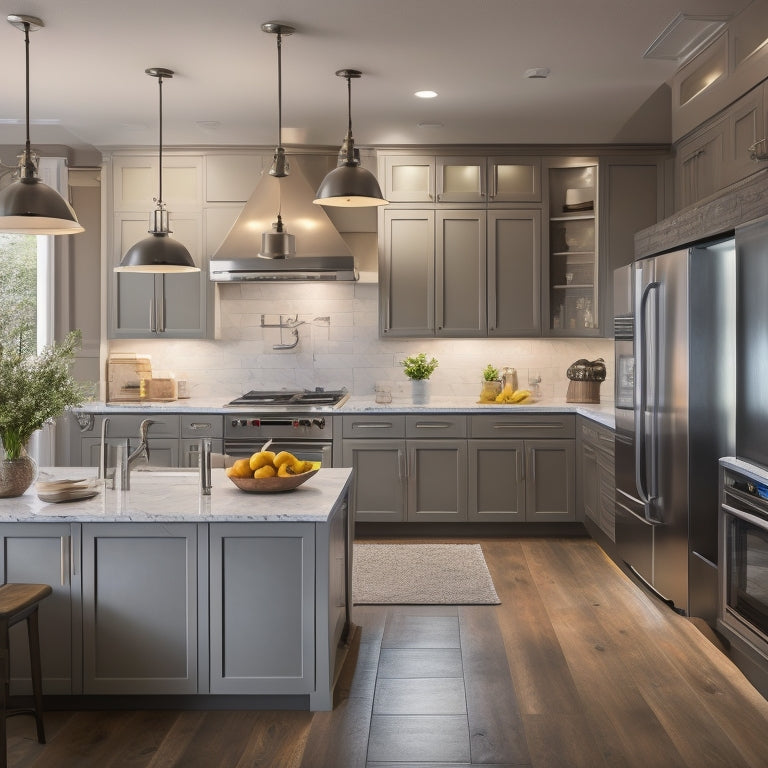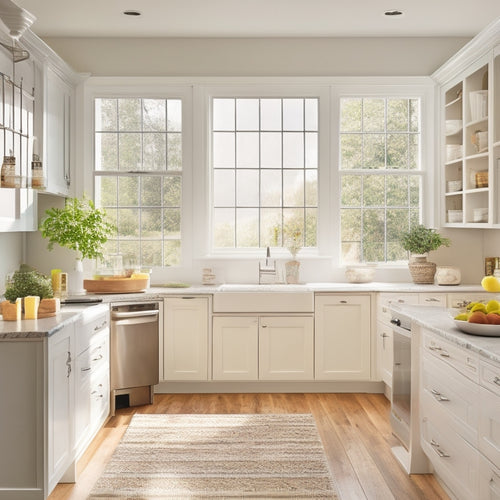
Optimize Your Kitchen: 7 Essential Layout Tips
Share
You're upgrading your kitchen, and a well-designed layout is key. Start by creating a "work triangle" zone with your sink, stove, and refrigerator, spaced 3-9 feet apart for efficient workflow. Balance storage and countertops by allocating space for high-priority tasks and organizing landing strips. Position appliances strategically, considering noise levels and traffic flow. Designate task zones for meal prep, cooking, and cleanup, and maximize corner cabinet space with carousels and pull-out shelves. Utilize vertical storage areas, like ceiling shelves and window ledges, and leave breathing room between countertops and appliances for a harmonious, functional space that sparks inspiration.
Key Takeaways
• Form a work triangle zone by placing the sink, stove, and refrigerator 3-9 feet apart to enhance workflow efficiency.
• Balance storage and countertops by allocating space strategically and utilizing pull-out shelves and dividers for optimization.
• Position appliances thoughtfully, considering noise zones and high-traffic areas to create a peaceful atmosphere.
• Designate task zones in the kitchen for meal prep, cooking, and cleanup to streamline food preparation and cooking.
• Maximize corner cabinet space with carousels, blind shelves, and pull-out baskets to optimize storage and reduce clutter.
Create a Work Triangle Zone
Position your sink, stove, and refrigerator to form a work triangle zone, with each point ideally 3-9 feet apart, to create a harmonious and efficient kitchen workflow. This zone is the heart of your kitchen, where you'll spend most of your time preparing meals. By keeping these essential elements within close proximity, you'll minimize walking distances and maximize productivity.
Imagine a triangle connecting these three points, with each leg representing the zone boundaries. This visual representation will help you optimize the layout and maintain kitchen harmony. Envision yourself moving seamlessly between tasks, with each step feeling natural and intuitive.
As you design your work triangle zone, consider the 'work' that will happen in each area. Will you need ample counter space near the sink for food prep? Do you prefer your stove adjacent to a window for natural light? By thoughtfully planning your zone, you'll create a kitchen that not only looks beautiful but also functions beautifully, making mealtime a true delight.
Balance Storage and Countertops
As you design your kitchen layout, you're faced with an essential balancing act: allocating countertop space and planning storage capacity. You'll want to strike a harmonious balance between the two, ensuring you have ample room to prep and cook while keeping clutter at bay.
Countertop Space Allocation
Your kitchen's workflow hinges on striking a balance between ample countertop space and strategic storage allocation, ensuring a harmonious coexistence of form and function.
When allocating countertop space, prioritize tasks that require the most surface area, such as food preparation and cooking. This will help you determine the ideal surface segregation. For instance, designate a specific zone for meal prep, keeping frequently used utensils and ingredients within easy reach.
Consider the 'golden triangle' concept, where your sink, stove, and refrigerator form the points of a triangle, allowing for efficient movement between tasks. Allocate countertop space accordingly, reserving areas closest to these points for high-priority tasks.
Be mindful of 'landing strips' – areas where you place items temporarily, like near the sink or stove. By thoughtfully allocating countertop space, you'll create a seamless workflow that makes cooking and entertaining a breeze.
Storage Capacity Planning
By thoughtfully balancing storage capacity with countertop space, you'll create a kitchen that's both beautiful and functional, where everything has its designated place and is easily accessible when you need it.
To achieve this harmony, focus on shelf management and cabinet optimization. Begin by categorizing your kitchen items into frequently used, occasionally used, and rarely used groups. This will help you allocate storage space efficiently. Assign prime real estate to everyday essentials, like coffee makers and utensils, and reserve upper shelves for infrequently used items, such as special occasion dishes.
Next, optimize your cabinet layout by grouping similar items together, like baking supplies or cooking utensils. Consider installing pull-out shelves, lazy susans, or dividers to maximize storage capacity and ease of access. By doing so, you'll create a sense of calm and control, making meal prep and cooking a joy.
With everything in its place, you'll feel more connected to your kitchen and more confident in your cooking abilities.
Workflow Triangle Efficiency
Imagine yourself moving seamlessly between tasks in your kitchen, where every step feels like a choreographed dance, with all the necessary tools and ingredients within arm's reach, thanks to a carefully crafted workflow triangle that balances storage and countertops.
This essential workflow triangle is the key to efficiency in your kitchen, allowing you to whip up a storm without breaking a sweat. The triangle geometry is vital, with the sink, stove, and refrigerator forming the three points. Make sure that each point is within easy reach, with no more than 9 feet between each station. This will streamline your task flow, reducing walking distances and increasing productivity.
Visualize your kitchen as a well-oiled machine, where every tool and ingredient has its designated spot. Countertops provide ample space for food preparation, while clever storage solutions keep utensils and ingredients organized and out of the way. By balancing storage and countertops, you'll create a kitchen that's both functional and beautiful.
With a well-designed workflow triangle, you'll feel like a culinary master, effortlessly gliding from one task to the next, with every element working in perfect harmony.
Position Appliances Strategically
Three key zones - cooking, cleaning, and food storage - will function more efficiently if you position your appliances strategically within them. By doing so, you'll create a harmonious workflow that makes cooking and entertaining a breeze.
When it comes to appliance placement, consider the 'noise zone' - where you'll place noisy appliances like the dishwasher and garbage disposal. Position them away from high-traffic areas and social hubs, like the kitchen island or breakfast nook, to minimize disruptions.
Meanwhile, place your refrigerator and oven in convenient locations that allow for easy access and minimal walking distances. This thoughtful approach to appliance placement won't only enhance your kitchen's functionality but also create a more peaceful and inviting atmosphere.
Designate Zones for Tasks
As you envision your ideal kitchen layout, consider dividing the space into distinct zones that cater to specific tasks. By doing so, you'll create a more efficient and organized cooking environment that flows beautifully.
You'll soon discover the benefits of assigning dedicated areas for meal prep, cooking, and cleanup, making your kitchen a true haven for culinary creativity.
Meal Prep Station
By designating specific zones for tasks within your meal prep station, you can streamline food preparation and cooking, creating a more efficient and enjoyable culinary experience.
This zone should be a portable station where you can easily access fresh ingredients and prep tools.
To create an effective meal prep station, consider the following essential components:
-
Ingredient Station: A dedicated area for storing and accessing fresh ingredients, such as a built-in produce bin or a countertop fruit bowl.
-
Prep Surface: A durable, easy-to-clean surface for chopping, slicing, and dicing ingredients, like a butcher block or stainless steel countertop.
-
Tool Hub: A convenient storage spot for frequently used prep tools, such as a utensil organizer or a knife block.
- Waste Station: A designated area for disposing of food waste and packaging, like a pull-out trash can or a recycling bin.
Cooking Zone Assignment
You can optimize your cooking workflow by dividing your kitchen into distinct zones, each dedicated to a specific task, such as food preparation, cooking, and serving. This Zone Identification process helps you streamline your cooking process, making it more efficient and enjoyable. By segregating tasks into separate zones, you'll avoid clutter and chaos, allowing you to focus on the task at hand.
Imagine having a dedicated space for meal prep, where you can chop, dice, and marinate ingredients without interruptions.
Adjacent to this zone, you can designate a cooking zone, where your stovetop, oven, and cookware come together to bring your dishes to life.
Clean-Up Central Hub
Designate a clean-up central hub near the cooking zone, where a sink, trash can, and storage for cleaning supplies converge to efficiently tackle meal aftermath. This zone is essential for maintaining a clutter-free kitchen and streamlining waste management. By centralizing cleaning essentials, you'll create a seamless workflow that reduces mess and stress.
Here's what your clean-up central hub should include:
-
Sink: A dedicated sink for cleaning up food waste and washing utensils.
-
Trash Can: A convenient spot for disposing of food waste and packaging.
-
Storage for Cleaning Supplies: A designated area for storing cleaning products, sponges, and scrubbers.
- Cleaning Station: A built-in cleaning station with a soap dispenser, scrubbing area, and paper towel holder.
Maximize Corner Cabinet Space
In the often-wasted real estate of corner cabinets, clever storage solutions can be employed to corral cookware, utensils, and gadgets, freeing up valuable space in the rest of your kitchen. By incorporating smart design elements, you can transform these dead zones into functional hubs.
Here are some ideas to get you started:
| Storage Solution | Description | Benefits |
|---|---|---|
| Corner Carousels | Rotating shelves that bring items to you | Easy access, reduced clutter |
| Blind Shelves | Hidden storage behind a door or panel | Conceals items, adds visual appeal |
| Pull-out Baskets | Sliding baskets for easy retrieval | Streamlined storage, increased visibility |
| Lazy Susans | Turntables for effortless access | Saves time, reduces strain |
| Adjustable Shelves | Customizable storage for varying sizes | Flexibility, adaptability |
Utilize Vertical Storage Areas
Optimizing your kitchen's vertical real estate by installing floor-to-ceiling storage units, shelves, or cabinets can greatly amplify your storage capacity while maintaining a sense of openness. This thoughtful design approach allows you to make the most of your kitchen's vertical space, creating a sense of airiness and freedom.
Here are some ways to effectively utilize vertical storage areas:
-
Ceiling Shelves: Install shelves that reach up to the ceiling to store infrequently used items, such as special occasion dishes or cookbooks.
-
Window Ledges: Utilize the space above your windows by adding decorative shelves or cabinetry to store spices, oils, or other kitchen essentials.
-
Tall Cabinets: Incorporate floor-to-ceiling cabinets to store bulk items, like canned goods or kitchen gadgets.
- Pull-Down Storage: Install pull-down storage units, such as a spice rack or a utensil holder, to maximize the space above your countertops.
Leave Breathing Room Between
By leaving a few inches of breathing room between your kitchen's countertops, appliances, and cabinets, you're creating a visually appealing sense of flow that makes the space feel more expansive and easier to navigate. This thoughtful layout consideration is essential for establishing a comfortable flow in your kitchen. Without it, the space can quickly feel cramped and overwhelming.
| Area | Recommended Breathing Room | Why It Matters |
|---|---|---|
| Countertops & Appliances | 1-2 inches | Prevents cluttered look, allows easy cleaning |
| Cabinets & Countertops | 2-3 inches | Creates visual flow, makes cabinetry appear more streamlined |
| Island & Main Countertops | 3-4 inches | Defines separate zones, enhances overall functionality |
Frequently Asked Questions
How Do I Choose the Right Kitchen Layout for My Lifestyle?
You're wondering how to choose the right kitchen layout for your lifestyle? Begin by evaluating your personal priorities, like cooking frequency and entertaining habits, to create a space that reflects your unique needs and style.
Can I Have a Kitchen Island and Still Maintain a Work Triangle?
As you envision your dream kitchen, you wonder if a kitchen island will disrupt the sacred work triangle. Fear not! With careful island size and strategic placement, you can create a harmonious workflow that's both functional and visually stunning.
What Is the Ideal Distance Between Countertops and Upper Cabinets?
When designing your kitchen, you'll want to strike a balance between ergonomic clearance and visual balance; ideally, leave 15-20 inches between countertops and upper cabinets to create a harmonious, functional space that feels tailored to you.
Are Soft-Close Cabinets and Drawers Really Worth the Extra Cost?
You crave a serene kitchen haven, where every open and close is a gentle whisper. Soft-close cabinets and drawers, aka Cabinet Hacks and Drawer Delights, are worth the splurge, as they exude sophistication, ensuring a peaceful cooking sanctuary that makes you feel like a culinary rockstar.
Can I DIY a Kitchen Layout or Should I Hire a Professional?
You're wondering if DIYing your kitchen layout is a good idea, but design fears and budget constraints are holding you back - can you really trust your instincts to create a cohesive, functional space that reflects your personal style?
Related Posts
-

Corner Kitchen Storage Solutions to Boost Efficiency
To boost efficiency in your kitchen, you'll want to strategically utilize corner storage solutions. Start by measurin...
-

Deighton Associates Awarded for Excellence in Asset Management
You're likely curious about Deighton Associates' recent recognition for excellence in asset management. They've recei...

